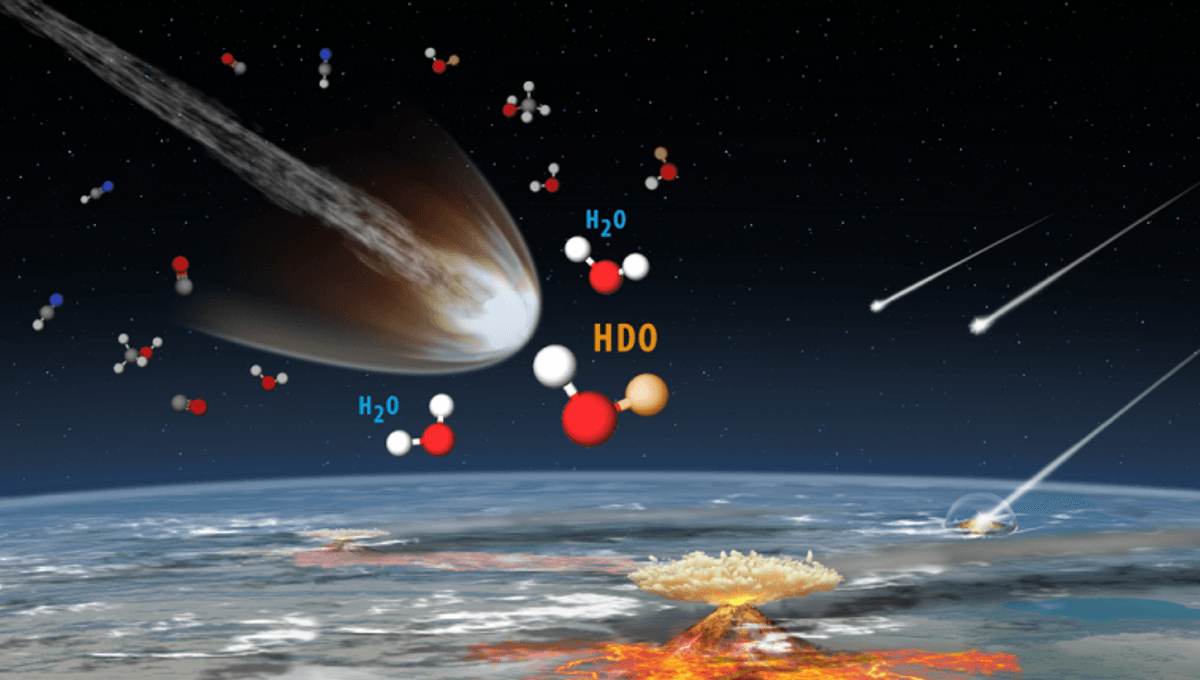-
Feed de notícias
- EXPLORAR
-
Páginas
-
Blogs
-
Fóruns
The Water In Comet Pons-Brooks Matches The Oceans – Did Comets Help Make Earth Habitable?

The Water In Comet Pons-Brooks Matches The Oceans – Did Comets Help Make Earth Habitable?
The origin of Earth's water is an open question. The Earth should have formed from pretty dry materials, so at least some of the water comes from extraterrestrial sources. Comets were the first possible culprit considered, but observations suggested that it was not the case. Now, new work brings the comet back to the table. The answer to the question "did comets help make Earth habitable?" is a solid maybe.
The rest of this article is behind a paywall. Please sign in or subscribe to access the full content. Water on Earth is mostly your classic H2O: two parts regular hydrogen and one part oxygen. It also has a sprinkling of heavy water (HDO), where one of the hydrogen atoms has an extra neutron, making it the isotope deuterium. The Earth’s water has a very specific isotopic signature. There are 33 grams of deuterium in every cubic meter of seawater; or, 0.0156 percent of water is HDO. Armed with that, scientists looked for water. Many comets did not match this ratio. That includes famous examples such as Halley, Hyakutake, and Hale-Bopp. Evidence mounted that some of it comes from the inner mantle, so not all water is extraterrestrial; but there are also asteroids, such as stony Itokawa, that have a water signature similar to Earth's. Now, researchers report ALMA (Atacama Large Millimeter Array) observations of comet 12P/Pons-Brooks, a Halley-type comet that goes around the Sun every 70 years or so. In its closest passage last year, scientists measured the composition of its atmosphere: the coma. They observed an isotopic ratio of 0.0171 percent, the lowest ever for this class of comets and within the uncertainty of Earth’s own ratio. “Comets like this are frozen relics left over from the birth of our Solar System 4.5 billion years ago,” lead author Martin Cordiner, from NASA’s Goddard Space Flight, said in a statement. “Since Earth is believed to have formed from materials lacking water, comet impacts have long been suggested as a source of Earth’s water. Our new results provide the strongest evidence yet that at least some Halley-type comets carried water with the same isotopic signature as that found on Earth, supporting the idea that comets could have helped make our planet habitable.” The work indicates that the picture of extraterrestrial water being delivered to Earth is complex. Maybe not all comets, but some comets. And comets have been shown to possess organic molecules that could have been the crucial components that started life on Earth. But asteroids, too, have been seen to have those components. It might be preferable to have a nice, simple answer – all comets or no comets, all asteroids or no asteroids – but the complexity suggests that there might not be a single way to get water and intriguing molecules delivered to a planet. This makes pathways for life more common. The work is a testament to the power of ALMA, which was able to zoom in on the comet’s detailed composition days before and after its closest approach to the Sun last year. The comet was over 250 million kilometers from Earth. “By mapping both H2O and HDO in the comet’s coma, we can tell if these gases are coming from the frozen ices within the solid body of the nucleus, rather than forming from chemistry or other processes in the gas coma,” said NASA’s Stefanie Milam, a co-author of the study. The study is published in Nature Astronomy.


